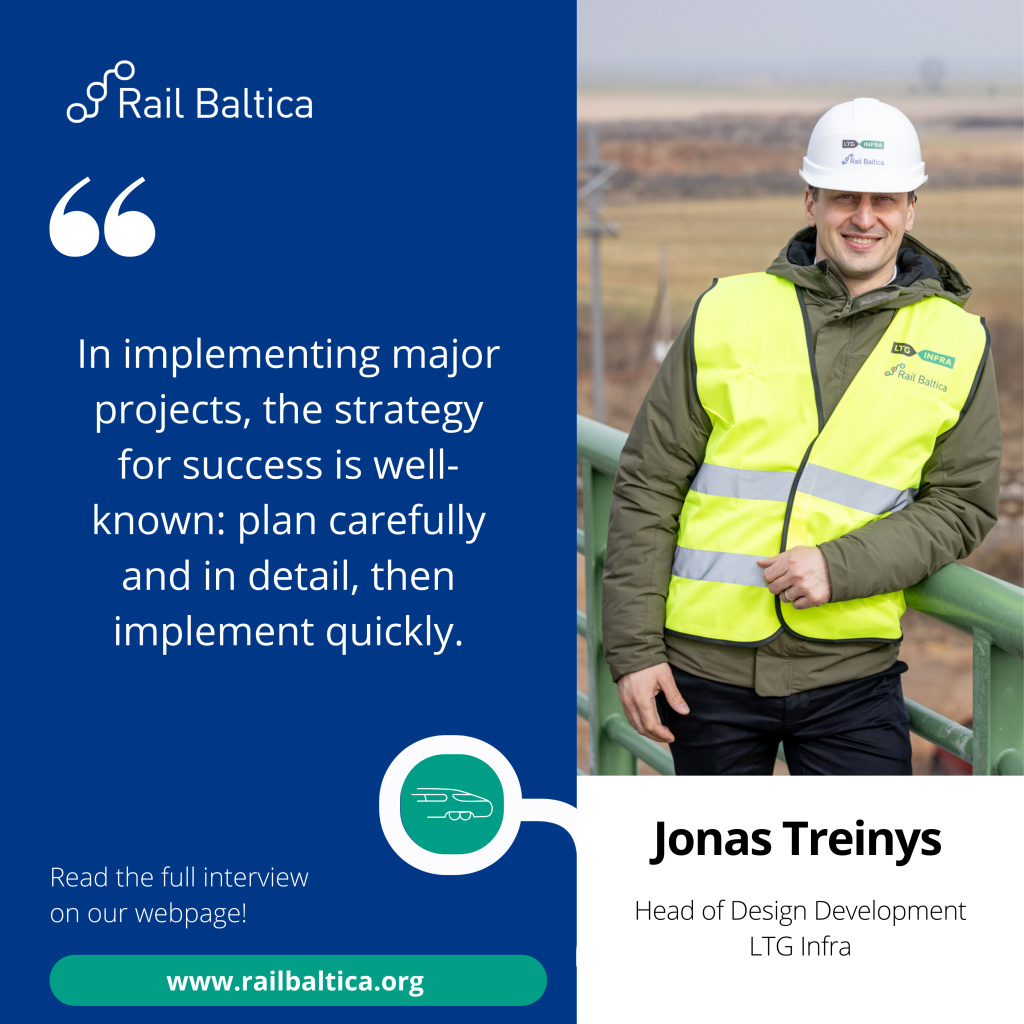Rail Baltica is a railway infrastructure megaproject that spans across several countries. The depth of skills and expertise required to successfully execute a greenfield project of this caliber is extensive and would not be possible without our diverse team of professionals.
Welcome back to our series, “Rail Baltica: The People Behind the Vision,” where we introduce you to the members of the Rail Baltica global project team. These individuals are the driving force advancing the Rail Baltica project with their professionalism, dedication, and passion for this project.
 Jonas Treinys, Head of Design Development, LTG Infra
Jonas Treinys, Head of Design Development, LTG Infra
Jonas Treinys, Rail Baltica Head of Design Development at LTG Infra, is responsible for the most important project preparation work even before the construction of the high-speed railway, including spatial planning, land acquisition for public needs and design of future sections throughout Lithuania. When planning and designing Rail Baltica, the principal characteristic of the world’s most successful megaprojects is followed.
When assessing the practice of major infrastructure projects, how much does the preparation for the project and its real implementation take?
Planning and preparation are important processes that help solve possible future problems more economically than during construction. In implementing major projects (regardless of the country, sector, or scale), the strategy for success is well-known: plan carefully and in detail, then implement quickly.
Fast construction allows us to avoid inflation, cost increases, and unforeseen geopolitical issues, such as a pandemic or war, as well as a lack of resources or financing. It takes at least a few years to both plan and design the railway line and engineering structures, and during this time, every aspect of the project is considered.
My colleagues told me, as a newcomer, that a megaproject is like the tip of the iceberg. You see the project and seem to know what we are building, but there is a lot of detail underneath that makes up its full scope.
It might seem that railway infrastructure is quite narrow. Why, then, are spatial planning and design so complicated?
Transport infrastructure has a significant urban impact because it aims to reach city centres, which are densely built-up and inhabited areas, rather than just the outskirts. Consequently, the impact on the population and businesses is substantial. Additionally, other important infrastructure is developed around cities, and cultural heritage and protected areas must also be considered. Reconciling the interests of different parties and finding the most suitable transport corridor is a challenge.
When planning infrastructure, we assess how it will serve the population in 20-30 years. This is a responsible and interesting job.
The Baltic States currently lack experience in designing high-speed rail infrastructure. How can we acquire this expertise, and what types of employees are needed for the Rail Baltica team at this stage?
We draw most of our experience from high-speed rail design leaders abroad, with whom we consult, and by attracting colleagues who have worked in this sector.
We are currently seeking a design team leader. There is substantial work in design management, including the design of a section crucial for Lithuania to the Polish state border, the Kaunas node, and completing the design work up to the Latvian border, followed by the Kaunas-Vilnius section. We are also discussing the future branch to Klaipėda. Thus, Rail Baltica will not stop at its first stage.
In addition to leading the preparation of future infrastructure, you are a rifleman. Do both roles relate to patriotism?
Rail Baltica seems to be a particularly patriotic project to me. We are working to integrate the Baltic States into the European railway network. From the current perspective, it is important for Lithuania to expand the possibilities of military mobility and working on a project that will ensure our security is one of the motivations.
Partisan Juozapas Streikus-Stumbras said in 1962: “We taught our children only to grow bread and plant trees, but we needed to teach them to shoot more accurately.” We live in a geopolitical region where we must learn how to build a European high-speed rail and, if necessary, protect it.
